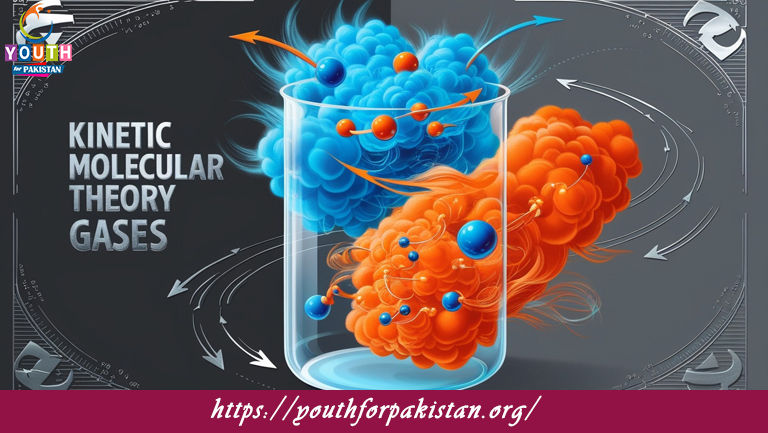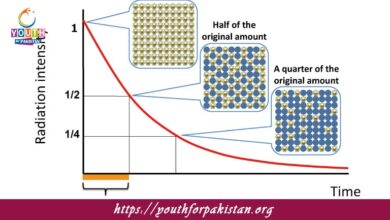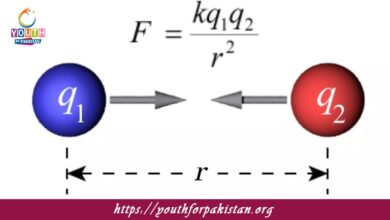Kinetic Molecular Theory Of Gases MDCAT MCQs with Answers

Welcome to the Kinetic Molecular Theory Of Gases MDCAT MCQs with Answers. In this post, we have shared Kinetic Molecular Theory Of Gases Multiple Choice Questions and Answers for PMC MDCAT 2024. Each question in MDCAT Chemistry offers a chance to enhance your knowledge regarding Kinetic Molecular Theory Of Gases MCQs in this MDCAT Online Test.
The Kinetic Molecular Theory of Gases assumes that gas molecules:
a) Have significant intermolecular forces
b) Are in constant, random motion
c) Are closely packed
d) Have no kinetic energy
According to the Kinetic Molecular Theory, the average kinetic energy of gas molecules is directly proportional to:
a) Pressure
b) Volume
c) Temperature
d) Number of moles
Which of the following is not a postulate of the Kinetic Molecular Theory?
a) Gas molecules are point masses with no volume
b) Gas molecules have strong intermolecular forces
c) Gas molecules collide elastically with each other and with the walls of the container
d) The average kinetic energy of gas molecules is proportional to the temperature in Kelvin
In the Kinetic Molecular Theory, the pressure of a gas is due to:
a) Gravitational forces between molecules
b) The random motion of the molecules and their collisions with the container walls
c) The volume of the gas molecules
d) The chemical reactions between molecules
Which statement best describes the relationship between the speed of gas molecules and their temperature according to the Kinetic Molecular Theory?
a) Higher temperature results in slower molecular speeds
b) Higher temperature results in faster molecular speeds
c) Temperature has no effect on molecular speed
d) Molecular speed is inversely proportional to temperature
According to the Kinetic Molecular Theory, the volume of individual gas molecules is:
a) Large compared to the volume of the container
b) Negligible compared to the volume of the container
c) Equal to the volume of the container
d) Zero
The Kinetic Molecular Theory assumes that gas molecules:
a) Have significant interactions with each other
b) Are not in motion
c) Move in straight lines between collisions
d) Have zero mass
What does the Kinetic Molecular Theory say about the collisions between gas molecules?
a) They are perfectly inelastic
b) They are partially elastic
c) They are elastic
d) They do not occur
The distribution of molecular speeds in a gas sample is described by which of the following?
a) Avogadro’s Law
b) The Maxwell-Boltzmann distribution
c) Charles’s Law
d) Boyle’s Law
In the Kinetic Molecular Theory, which factor primarily influences the average kinetic energy of gas molecules?
a) Pressure
b) Volume
c) Temperature
d) Number of gas molecules
According to the Kinetic Molecular Theory, gas molecules exert pressure on the walls of their container because:
a) They are attracted to the walls
b) They are repelled by the walls
c) They collide with the walls of the container
d) They have no effect on the walls
Which of the following conditions is least likely to cause a gas to deviate from ideal behavior according to the Kinetic Molecular Theory?
a) High pressure
b) Low temperature
c) Low pressure
d) High temperature
The Kinetic Molecular Theory assumes that gas molecules:
a) Have no volume
b) Occupy a significant fraction of the container’s volume
c) Are constantly undergoing chemical reactions
d) Have attractive forces
According to the Kinetic Molecular Theory, which of the following factors does not affect the rate of molecular collisions?
a) Temperature
b) Volume
c) Number of molecules
d) Molecular mass
The Kinetic Molecular Theory explains the behavior of gases under:
a) All conditions of temperature and pressure
b) High pressure only
c) Low temperature only
d) Standard temperature and pressure only
According to the Kinetic Molecular Theory, which of the following has the highest average molecular speed?
a) Heavy gas molecules at low temperature
b) Heavy gas molecules at high temperature
c) Light gas molecules at low temperature
d) Light gas molecules at high temperature
The Kinetic Molecular Theory assumes that the intermolecular forces between gas molecules are:
a) Strong
b) Moderate
c) Weak
d) Negligible
Which of the following laws is most directly related to the Kinetic Molecular Theory of gases?
a) Charles’s Law
b) Boyle’s Law
c) Avogadro’s Law
d) Dalton’s Law
According to the Kinetic Molecular Theory, the mean free path of gas molecules is:
a) The distance a molecule travels before it collides with another molecule
b) The distance between the walls of the container
c) The distance between the molecules themselves
d) The volume occupied by a single molecule
Which of the following is a consequence of the Kinetic Molecular Theory regarding the diffusion of gases?
a) Gases do not diffuse
b) The rate of diffusion is independent of temperature
c) The rate of diffusion is directly proportional to the square root of the molecular mass
d) The rate of diffusion is inversely proportional to the molecular mass
In the Kinetic Molecular Theory, what happens to the average kinetic energy of gas molecules if the temperature is doubled?
a) It is halved
b) It remains constant
c) It doubles
d) It quadruples
According to the Kinetic Molecular Theory, gas molecules move in:
a) Circular orbits
b) Random straight lines
c) Oscillatory paths
d) Elliptical orbits
According to the Kinetic Molecular Theory, the pressure exerted by a gas is due to:
a) Attractive forces between molecules
b) Repulsive forces between molecules
c) The constant random motion of molecules and their collisions with the container walls
d) The volume of the gas molecules
What effect does increasing the temperature have on the molecular speed of a gas, according to the Kinetic Molecular Theory?
a) It decreases molecular speed
b) It increases molecular speed
c) It has no effect on molecular speed
d) It decreases molecular speed only at high temperatures
Which of the following statements about gas molecules is consistent with the Kinetic Molecular Theory?
a) They are stationary in the container
b) They exhibit significant repulsive forces
c) They occupy a large fraction of the container’s volume
d) They are in constant, random motion and collisions are elastic
The Kinetic Molecular Theory best explains the behavior of gases under which conditions?
a) High pressure and low temperature
b) High pressure and high temperature
c) Low pressure and high temperature
d) Low pressure and low temperature
In the context of the Kinetic Molecular Theory, what does “elastic collisions” mean?
a) Molecules stick together after collision
b) Kinetic energy is lost in the collision
c) Kinetic energy is conserved during collisions
d) Molecules become ionized after collision
According to the Kinetic Molecular Theory, which of the following factors does not affect the average kinetic energy of gas molecules?
a) Pressure
b) Temperature
c) Molecular mass
d) Volume
Which concept describes the average distance a gas molecule travels before colliding with another molecule?
a) Mean free path
b) Molecular speed
c) Collision frequency
d) Diffusion rate
In the Kinetic Molecular Theory, if a gas is compressed to a smaller volume while maintaining constant temperature, what happens to the pressure?
a) It decreases
b) It remains constant
c) It increases
d) It becomes zero
The Kinetic Molecular Theory implies that gas molecules:
a) Are influenced by strong intermolecular forces
b) Are in constant, orderly motion
c) Have a significant volume compared to the container
d) Do not have significant interactions with each other
According to the Kinetic Molecular Theory, which of the following is true about the motion of gas molecules?
a) They move in circular paths
b) They move with constant speed
c) They move in straight lines until they collide with other molecules or the walls of the container
d) Their motion is highly organized
According to the Kinetic Molecular Theory, how does the average speed of gas molecules change with an increase in temperature?
a) The average speed decreases
b) The average speed remains constant
c) The average speed increases
d) The average speed becomes unpredictable
The Kinetic Molecular Theory predicts that gas pressure will increase if:
a) The volume is increased
b) The temperature is decreased
c) The number of gas molecules is increased
d) The temperature is constant
Which of the following best describes the effect of increasing volume on the behavior of gas molecules according to the Kinetic Molecular Theory?
a) The frequency of collisions decreases
b) The temperature of the gas decreases
c) The speed of the gas molecules increases
d) The pressure of the gas decreases
According to the Kinetic Molecular Theory, if the volume of a gas is doubled while keeping temperature constant, the pressure:
a) Doubles
b) Halves
c) Remains constant
d) Quadruples
According to the Kinetic Molecular Theory, which of the following factors does not influence the kinetic energy of a gas molecule?
a) Temperature
b) Molecular mass
c) Pressure
d) Volume
The Kinetic Molecular Theory of gases assumes that gas molecules:
a) Are constantly forming new bonds
b) Move in a uniform pattern
c) Have negligible size compared to the container volume
d) Have significant interaction forces
In the Kinetic Molecular Theory, which of the following does not describe the behavior of gas molecules?
a) Gas molecules are in constant, random motion
b) Gas molecules occupy a small volume relative to the container
c) Gas molecules have strong intermolecular forces
d) Gas molecules collide elastically with each other
In the Kinetic Molecular Theory, which of the following best describes the average kinetic energy of gas molecules?
a) It is independent of temperature
b) It is directly proportional to the temperature of the gas
c) It is inversely proportional to the pressure
d) It remains constant regardless of the conditions
If you are interested to enhance your knowledge regarding Physics, Chemistry, Computer, and Biology please click on the link of each category, you will be redirected to dedicated website for each category.





